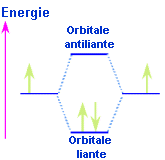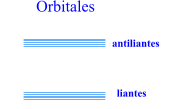 |
 UPS UPS |
|||||||||

Ultraviolet electron spectroscopy is used with metallic material, semiconductors, alloys, adsorbed layers. It is dedicated to band structure study.
This technique involves a UV lamp for the radiation source. Ionised helium is emitting light in the ultraviolet range. Depending on the gas flow, i.e. gas density in the ionisation chamber, two different emissions can be obtained. These emissions are classified according to their energy: By characterising band structures this spectroscopy allows to:  Determination of the chemical species that are presents at the very surface of a specimen Determination of the chemical species that are presents at the very surface of a specimen
When two atoms are being bound by a chemical bond, they are building a molecule, the atomic orbitals of these atoms are modified and this new arrangement creates a new equilibrium.
 Atom A Molecule AB Atom B The same process occurs again if a new atom encounters the molecule. In this way, we turn from a chemical binding into a band structure as shown by the following video sequence.  This shows that the band structure of each molecule has its own spectral signature. By studying the structure it is possible to determine the chemical nature of a surface. |